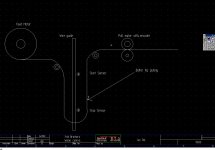Hi Guys,
Mike, I believe you're way high on your SWAG. I've done a lot of studying and calculating on this setup, and it really comes down to the moment of inertia of the moving mass (the 500# roll of wire, plus the turntable device that carries it) and the desired acceleration rate. Of course, there are also nominal friction losses in the system that may just have to be estimated.
The amount of torque to rotate the mass at the desired speed (about 10 RPM, in this case) yields the running torque, which needs to be added to the acceleration torque (the torque required to accelerate the mass to the desired speed, in the desired time interval) to give the total torque requirement. This would be a maximum amount, as the acceleration torque only applies at startup.
The equations used to arrive at these torque values are based on rotating the load directly, thru its own axis of rotation. If the OD of the roll of wire is 24", and the OD of the driving roller is 2", there is a 12:1 mechanical advantage. And if the driving roller is driven by the motor thru a 3:1 gearbelt reduction, then there is a total mechanical advantage between the output shaft of the motor and the driven load of 36:1. This reduces the effective torque requirement considerably.
Since I'm still waiting on the exact dimensions of the wire roll, I can't calculate the total torque requirement at the motor, but I'm guessing that it will be something less than 12 in-lbs. (This is figuring on the wire roll rotating at about 10 RPM, and allowing a generous 2 seconds to accelerate to the desired speed of 12"/sec.)
The 12"/sec wire speed translates to around 360 RPM motor speed.
HP = (RPM x TORQUE)/63,000
HP = (360 x 12 in-lb)/63,000
HP = .07 approx.
This is not figuring in frictional loads and losses, nor a design safety factor.
Of course, stepper motors are not normally rated in horsepower, as AC motors generally are. But for comparison, the largest stepper motor that AD sells has a max. torque output that goes from around 20 in-lb. at 40 RPM to around 3 in-lb. at 500 RPM (in half-stepping mode). Which kind of tells me that it's on the borderline as far as working in this application. Pretty much like you figured.
This is all FWIW, as I'm still flailing for absolutes at this point.




